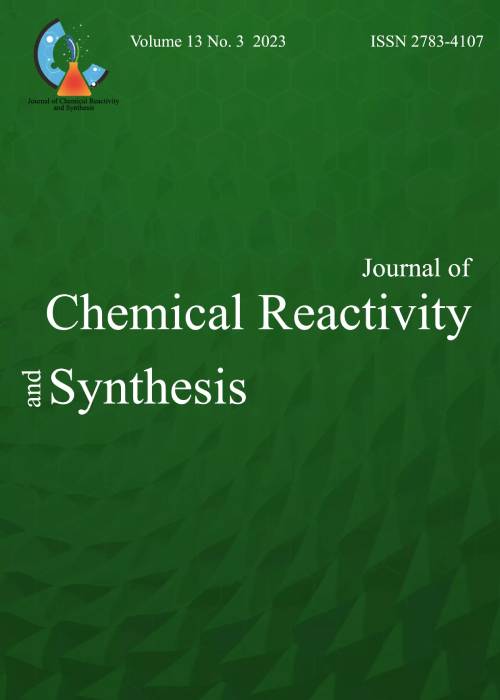فهرست مطالب
Journal of Chemical Reactivity and Synthesis
Volume:8 Issue: 2, Spring 2018
- تاریخ انتشار: 1396/06/14
- تعداد عناوین: 6
-
Pages 13-17
Phosphorus pentoxide used on alumina (P2O5/Al2O3) as an inexpensive, eco-friendly and non-toxic acid catalyst for the one-pot synthesis of 1,8-dioxo-octahydroxanthenes via multi-component reactions under solvent-free conditions. The present approach offers several advantages such as short reaction times, high yields, easy purification, recovery and reusability of the catalyst.
Keywords: 1, 8-Dioxo-octahydroxanthenes, Solvent-free, Multicomponentreactions, Phosphorus pentoxide used on alumina -
Pages 18-25
In this study, multi component Hantzsch reaction was carried out between various Aromatic Aldehyde with Dimedone,Ethyl acetateand ammonium acetate to produce polyhydroquinolinederivatives under solvent-free conditions at 110oC by a (Zinc oxide nanocatalyst) as effective Lewis acid. The remarkable advantages offered by this method compared with other methods are a green catalyst, simple work-up procedures, fast reactions, a long high yields.
Keywords: Zinc oxide nanocatalyst, solvent free, Polyhydroquinolin derivatives, multi –component reaction, green synthesis -
Pages 26-32
An efficient cyclization of 2’-hydroxychalcone to flavanone using calcium chloride as a catalyst was developed. The scope of the reaction was studied with substituted 2’-hydroxychalcone and these chalcones was converted into corresponding flavanone in good yield. The merits of this method are inexpensive and easily available catalyst, easy workup procedure, avoid use of toxic solvent.
Keywords: 2’-hydroxy chalcone, flavanone, calcium chloride, intramoleclar, Oxamichael reaction -
Pages 33-42
A magnetically recoverable catalyst consisting of Mn (III) salophen complex was prepared. The synthesized catalyst was characterized by X-ray powder diffraction (XRD), transmission electron microscopy (TEM), vibrating sample magnetometry (VSM), inductively coupled plasma atomic emission spectroscopy (ICP-AES) and Fourier transform infrared (FT-IR). The immobilized catalyst was shown to be an efficient heterogeneous catalyst for the epoxidation of various alkenes using hydrogen peroxide (H2O2) as oxidant. The catalyst could be easily and efficiently isolated from the final product solution by magnetic decantation and be reused for 5 consecutive reactions without showing any significant activity degradation
Keywords: Cobalt ferrite, Epoxidation, Magnetic nanoparticles, Surfacefunctionalization, Mn (III) salophen complex -
Pages 43-54
A new polyvinyl choloride (PVC) membrane sensor for cerium (III) was prepared based on 4,13-didecyl-1,7,10,16-tetraoxa-4,13-diazacyclooctadecane (kryptofix22DD) as an ionophore. The sensor exhibites a linear concentration range of 1.0×10-6 to 1.0×10-1 M, with a Nernstian slope of 18.0±1.0 mV/decade, and a detection limit of 9.7×10-7 M. It has a fast response time (5 s) and can be used for two months without any considerable divergence in its potential. The proposed sensor revealed high selectivity toward Ce3+ ion with respect to some alkali, alkaline earth and transition metal cations. It could be used in a wide pH range of 2.0-11.0. The sensor was successfully used as an indicator electrode in potentiometric titration of Ce3+ ion with ethylenediaminetetraacetic acid (EDTA) and sodium iodide (NaI) solutions, and in determination of Ce (III) concentration in real samples.
Keywords: PVC membrane, Cerium (III) selective sensor, Kryptofix22DD, Potentiometry -
Pages 55-61
Ab initio HF/6-31G* Methode was employed to calculate the bond length in 2- phosphinanes when electronegative groups was at C-2 tend axial and equatorial positions. The magnitude of the anomeric effect depends on the nature of the substituent, the effect of the substituent can be seen by comparing the bond length in 2-chloro and 2-boromo substituented phosphinanes. The effect of anomeric effect have been effected on the bond length in
2- phosphinanes.Keywords: anomeric effect, 2- phosphinane, bond length, axial, equatorial position, Ab initio calculations


